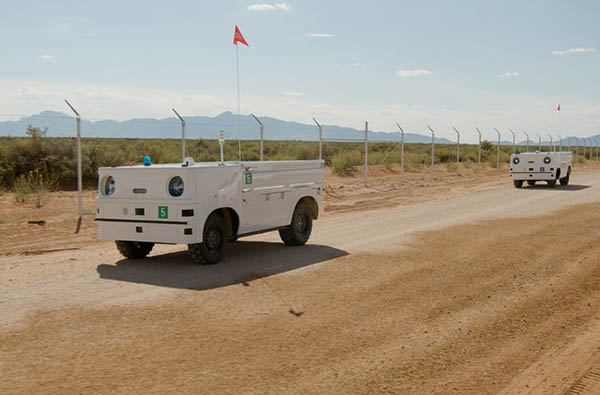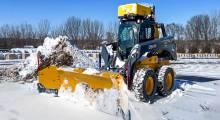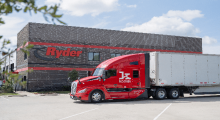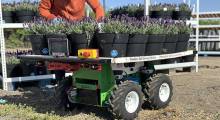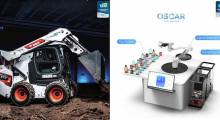Honda Motor Co. today said it has successfully tested a prototype Honda Autonomous Work Vehicle (AWV) at a Black & Veatch construction site in New Mexico. During the month-long field test, the second-generation prototype of the fully-electric Honda AWV performed a range of tasks at a large-scale solar energy project, including towing and transporting construction materials, water, and other supplies to pre-set destinations within the worksite.
“With our test partner, Black & Veatch, Honda was able to demonstrate the performance of our rugged all-electric Autonomous Work Vehicle prototype in a large-scale construction environment,” said Kenton Williams, U.S. project lead for the Honda AWV. “We believe the Honda AWV has the potential to bring greater efficiencies, higher levels of safety and better environmental performance to the construction industry, and to other industries seeking an autonomous off-road solution.”
First introduced as a concept at CES 2018 in Las Vegas, the Honda AWV combines the company's rugged off-road side-by-side platform with emerging autonomous vehicle technology. The company said the result is a new category of work vehicle that can be deployed in a variety of dynamic environments.
Honda picks Black & Veatch test site
The Honda Autonomous Work Vehicle uses a sensor suite including GPS for location, radar and lidar for obstacle detection, and stereoscopic (3D) cameras for remote monitoring. The vehicle also can be operated by remote control.
| Vehicle dimensions | 9' 6” L x 4' 8” H x 4' 11” W |
| Unladen vehicle weight | 721 kg (1,590 lb.) |
| Maximum loading capacity | 399 kg (880 lb.) |
| Towing weight limit | 750 kg (1, 653 lb., including the weight of a trailer) |
| Minimum turning radius | 3.9 m (12 ft., 9.5 in.) |
| Range at maximum loading capacity | Up to 45 km (27.9 mi., depending on the use case) |
| Charge time | Up to 6 hours (120V) |
In order to validate the AWV's capabilities, Honda chose an active construction site where support structures for solar panels were laid out in a grid pattern at regular intervals. The company used the site to test the ability of the Honda AWV to stop at precise points along a pre-set route.
Global engineering, procurement and construction company Black & Veatch collaborated with Honda to provide a real-world testing ground to validate the Honda AWV technology.
“Black & Veatch's pursuit of construction innovation and safety on job sites has led us to this relationship with Honda,” said Mario Azar, president of Black & Veatch's global power business. “With our leading market position in solar power, the testing of this new autonomous work vehicle aligns with our focus on advancing the industry through new and innovative ways to work at project sites.”
Honda's engineers trained personnel from the company on the operation and safety protocols of the vehicles to effectively use the technology in the field.
Honda produced a high-definition map of the 1,000-acre site that allowed Black & Veatch operators to precisely set start and stop points for multiple Honda AWVs using a cloud-based app interface that runs on tablets and PCs.
Overland Park, Kan.-based Black & Veatch provided detailed feedback for product and business requirements to further develop the Honda AWV's capabilities and services.
Field test delivers positive results
The Autonomous Work Vehicles successfully delivered materials and supplies along a calculated route and proved capable of stopping within centimeters of the preset points, said the companies.
The field test also demonstrated the viability of the vehicle's battery system to support energy-intensive sensors and provide propulsion while operating up to eight hours in a high-temperature environment. The vehicle carried payloads of nearly 900 lb. (408.2 kg).
In a separate use case, the Honda AWV towed a trailer carrying over 1,600 lb. (725.7 kg).
Autonomous Work Vehicle could find use in multiple industries
Based on this field test, Honda said it believes its Autonomous Work Vehicle can provide a wide range of services to a variety of industries that need a rugged off-road autonomous system. This is especially true where workforce constraints and safety concerns make other systems impractical, it said.
The ability to operate autonomously – or via remote control – and carry large payloads, along with the potential to add attachments and tools, makes the Honda AWV a suitable platform for many environments, said Honda.
Honda has not announced commercialization plans for the Honda AWV, but it is continues to develop and test the platform. Companies interested in testing the Honda AWV to assess applicability to their work environments can contact Honda at: [email protected].
Honda said it anticipates further improvements to performance and design specifications as development of the Honda AWV prototype continues to advance.
Article topics
Email Sign Up

